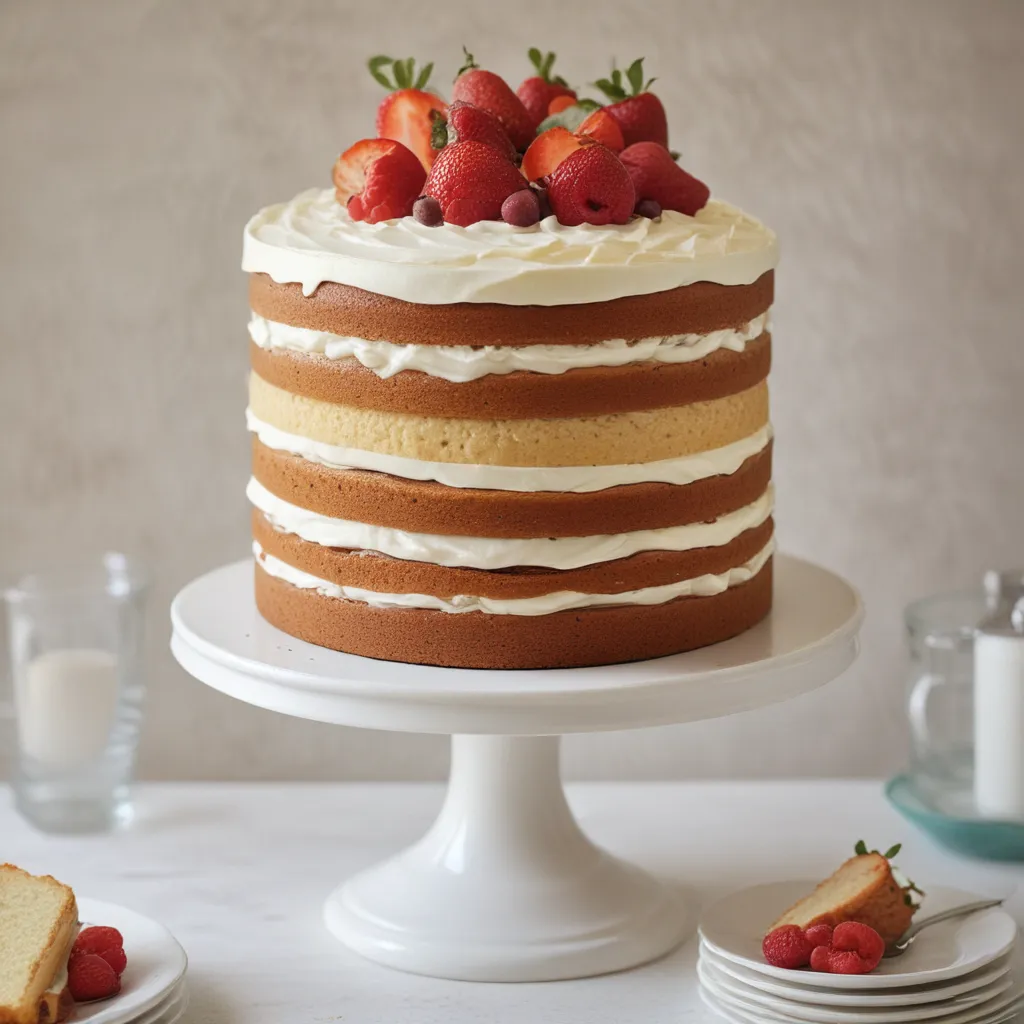Ah, the elusive macaron – those delicate, dainty French cookies that have captivated the hearts and taste buds of dessert enthusiasts worldwide. As the owner of Jax Cake Shop, I’ve had the pleasure of creating countless batches of these confectionary marvels, each one a testament to the art of precision and patience. But I know firsthand that mastering the macaron can be a daunting task, fraught with challenges and frustrations.
The Macaron Mystique
Let’s be honest – when I first started out, the macaron was a mysterious, almost mythical creature. How on earth could such a delicate, seemingly simple cookie require so much care and attention to get just right? The perfect macaron, with its delicate, paper-thin shell and soft, chewy interior, seemed like the holy grail of baking. And I’ll admit, there were more than a few failed batches that ended up in the trash before I finally cracked the code.
But you know what they say – the journey is half the fun, and that certainly holds true for the macaron-making process. I’ve learned that with the right techniques and a little bit of patience, anyone can become a macaron master. It’s all about understanding the science behind these French favorites and learning to work with the quirks of the ingredients.
Mastering the Macaron
So, what exactly does it take to create the perfect macaron? First and foremost, it’s all about precision. Macaron baking is a delicate dance, where even the slightest deviation from the recipe can spell disaster. From properly aging the egg whites to achieving the perfect macaronage (the process of gently folding the dry ingredients into the meringue), every step requires meticulous attention to detail.
One of the biggest challenges I’ve encountered is getting the signature “feet” – those delicate ruffles that form at the base of the macaron. This seemingly simple detail is actually the result of a complex chemical reaction, where the batter expands and sets just right during the baking process. It’s a fine line between too much and too little, and it takes a keen eye and a steady hand to get it just right.
But fear not, my fellow macaron enthusiasts! With a little bit of practice and some tried-and-true tips, you too can become a macaron master. Let’s dive in and explore the secrets to creating those perfect, Instagram-worthy cookies.
Ingredients and Preparation
At the heart of every successful macaron lies a carefully curated list of ingredients. The classic macaron recipe calls for just a few simple components: almond flour, powdered sugar, egg whites, and granulated sugar. But the way you handle and combine these elements can make all the difference.
First and foremost, the quality of your ingredients is paramount. Opt for the freshest, highest-quality egg whites you can find, and make sure your almond flour is finely ground and free of any lumps or impurities. The powdered sugar should be sifted to remove any unwanted clumps, and the granulated sugar should be fine and even in texture.
One of the most critical steps in the macaron-making process is the proper aging of the egg whites. This is where patience truly becomes a virtue. By letting the egg whites sit at room temperature for 24 to 48 hours, you’re allowing the proteins to break down and the moisture to evaporate, resulting in a more stable, meringue-like consistency. Trust me, this extra step is worth the wait!
Mixing and Piping
Once you’ve assembled your ingredients, it’s time to get to work. The key to successful macaron mixing lies in a technique called macaronage, where you gently fold the dry ingredients into the meringue. This delicate process requires a light touch and a keen eye, as overmixing can lead to flat, cracked cookies, while undermixing can result in dense, uneven shells.
As you fold, you’ll want to pay close attention to the consistency of the batter. It should have a smooth, glossy sheen and a ribbon-like texture that slowly folds back into itself when you lift the spatula. This is the sweet spot – not too thick, not too thin, but just right.
And when it comes to piping the macaron batter onto your baking sheets, precision is paramount. Using a piping bag fitted with a round tip, pipe evenly sized discs, spacing them apart to allow for proper expansion during baking. This step can take some practice, but with a steady hand and a little bit of patience, you’ll be piping like a pro in no time.
Baking and Drying
Ah, the baking and drying process – the moment of truth for any macaron enthusiast. This is where all your hard work and attention to detail come together to create those coveted, picture-perfect cookies.
The key to successful macaron baking lies in maintaining a consistent oven temperature and keeping a close eye on the cookies as they bake. Depending on your oven, you may need to experiment with temperatures ranging from 275°F to 325°F, finding the sweet spot that allows the shells to develop their signature feet and dry to a smooth, glossy finish.
But the real magic happens during the drying process, where the piped macaron discs are left to sit at room temperature for 30 to 60 minutes before baking. This drying period is crucial for the formation of that delicate, paper-thin shell – the hallmark of a truly exceptional macaron.
Filling and Flavoring
Once your perfectly baked macaron shells have cooled, it’s time to bring them to life with a delectable filling. The possibilities are endless when it comes to macaron fillings, from classic buttercream and ganache to more creative options like fruit preserves, caramel, or even savory fillings like herbed cream cheese.
One of my personal favorite fillings is a rich, creamy chocolate ganache. The contrast between the light, airy shell and the decadent, velvety ganache is simply divine. And the best part? Ganache is a breeze to make, requiring just a few simple ingredients and a bit of patience as it cools and thickens to the perfect piping consistency.
But don’t be afraid to get creative with your flavor profiles! Macaron shells can be easily tinted with food coloring or infused with all sorts of aromatic ingredients, like ground spices, citrus zest, or even finely chopped herbs. The possibilities are truly endless, and it’s a great way to showcase your baking prowess and personal style.
Troubleshooting and Tips
Of course, no macaron-making journey would be complete without a few bumps in the road. Whether it’s cracked shells, hollow interiors, or the dreaded “feet-less” wonders, there’s always a solution to be found.
One of the most common issues I’ve encountered is the dreaded “feet-less” macaron. This can often be attributed to undermixing or overbaking, but a few simple tweaks to your technique can help you achieve those coveted ruffled bases. Make sure you’re folding the batter just enough to achieve the right consistency, and experiment with your oven temperature and baking time until you find the sweet spot.
Another common problem is the hollow macaron shell, where the interior collapses instead of maintaining its signature chewy texture. This can be caused by a number of factors, from overbeating the meringue to not letting the piped discs dry for long enough before baking. Pay close attention to your mixing technique and drying times, and you’ll be well on your way to perfectly full, chewy macaron shells.
But perhaps the most frustrating issue of all is the dreaded cracked shell. This can happen for a variety of reasons, from fluctuations in oven temperature to the batter being too dry. One technique I’ve found particularly helpful is the “macaronage” method, where you gently fold the dry ingredients into the meringue until the batter achieves the perfect, glossy consistency.
Embracing the Macaron Journey
At the end of the day, the joy of making macarons lies not just in the final product, but in the journey itself. It’s a process that requires patience, precision, and a willingness to experiment and learn from your mistakes. And trust me, I’ve made my fair share of macaron mishaps over the years.
But that’s the beauty of it, isn’t it? Each failed batch is an opportunity to improve, to fine-tune your technique, and to develop a deeper appreciation for the art of macaron-making. And when you finally crack the code and pull that first perfect batch of macarons from the oven, the sense of accomplishment is unparalleled.
So, my fellow macaron enthusiasts, I urge you to embrace the process, to revel in the challenges, and to find the pure, unadulterated joy in creating these delicate, delightful French cookies. With a little bit of practice and a whole lot of love, you too can become a macaron master. And who knows – maybe one day, you’ll be sharing your own macaron-making tips and tricks on the Jax Cake Shop blog.
Until then, happy baking, and don’t forget to stop by https://www.jaxcakeshop.com/ for all your custom cake and macaron needs!





